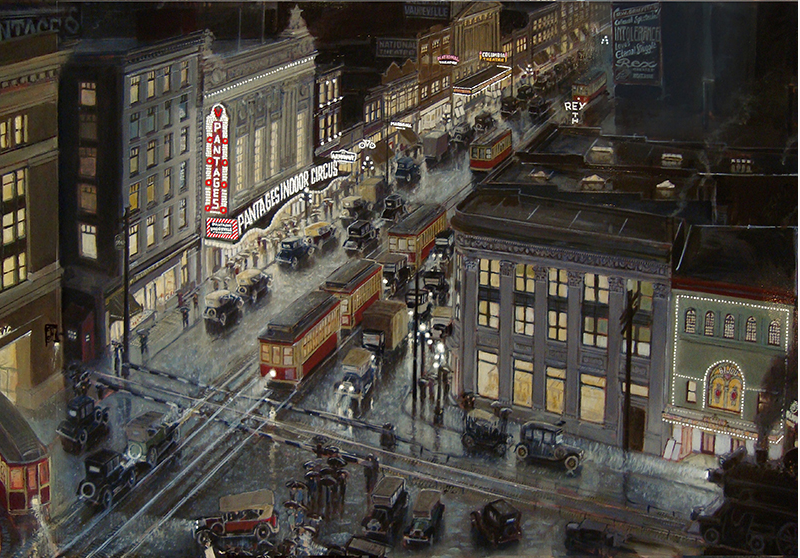
From Vancouver Exposed: Searching for the City’s Hidden History
Did you know that a commuter train used to run right through downtown Vancouver? I found out about it when I was over at Tom Carter’s studio checking out one of his amazing paintings. There it was, a train chugging across Hastings Street.
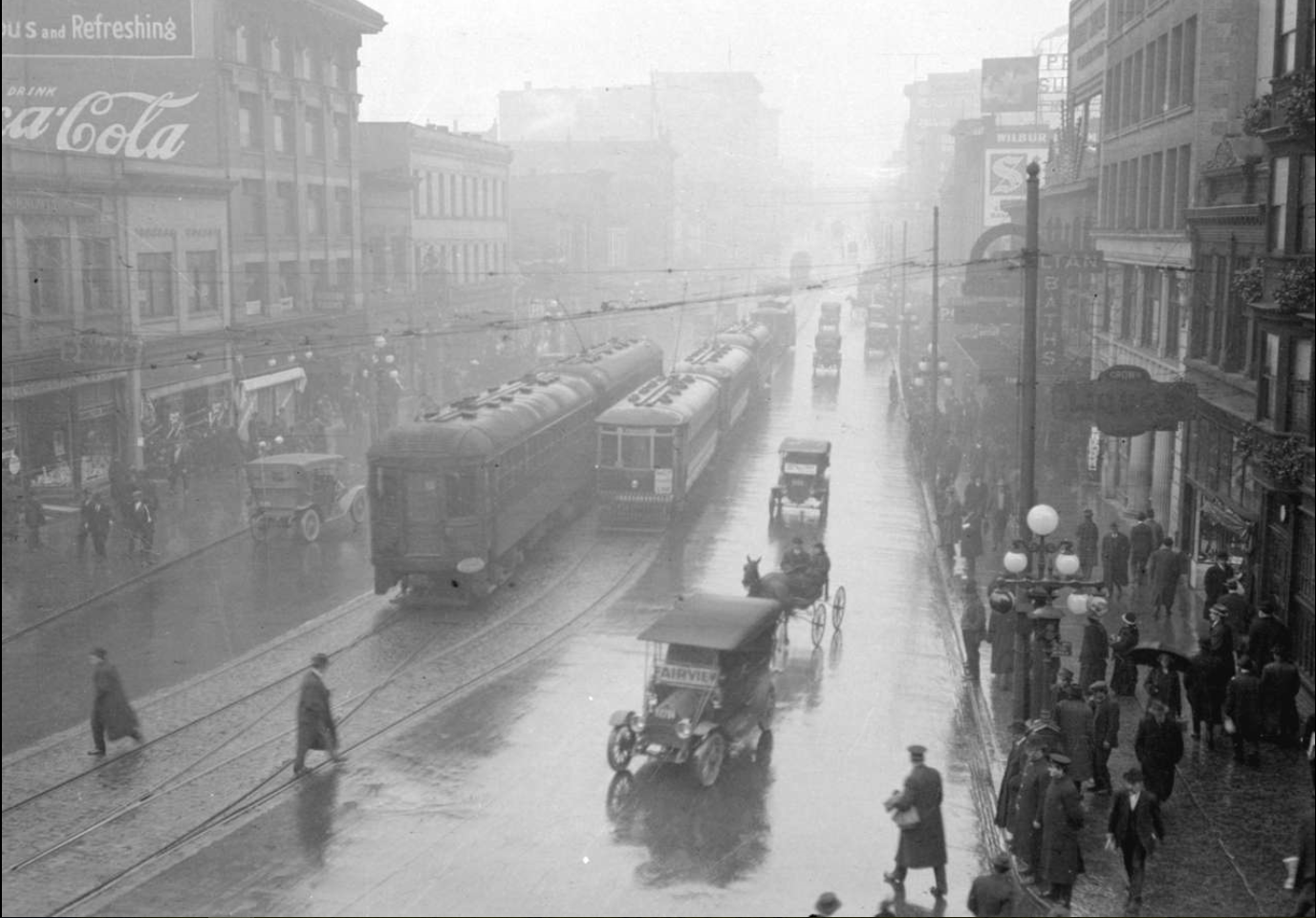
The train came up again when I was writing a blog post a couple of weeks ago about getting the star of Blood, Sweat, and Fear—Inspector Vance—from his home in Yaletown to his lab at Hastings and Main Street. The 1907 map that I downloaded from Vancouver Archives showed four large blocks from Hastings to Water Street and from Cambie to Carrall Street were occupied by the BC Electric Railway Company.
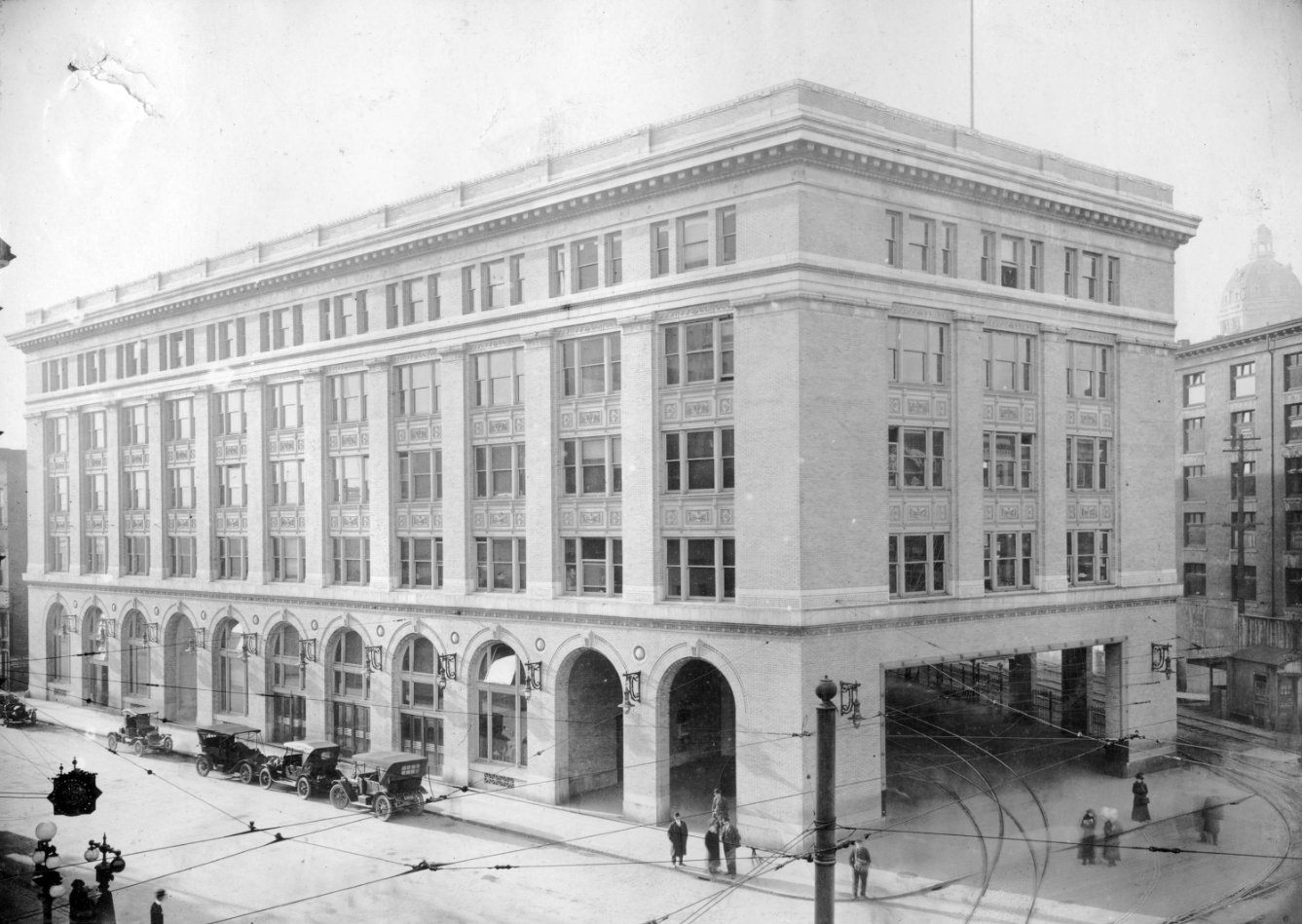
The streetcars were already in place by then, in fact had been since 1891, but the interurban train came later, in 1911 after the BCER opened its spiffy new terminal, and a car full of officials made the first trip from Vancouver to New Westminster on March 1.
It’s hard to imagine now, but over five kilometres of track ran through city streets.
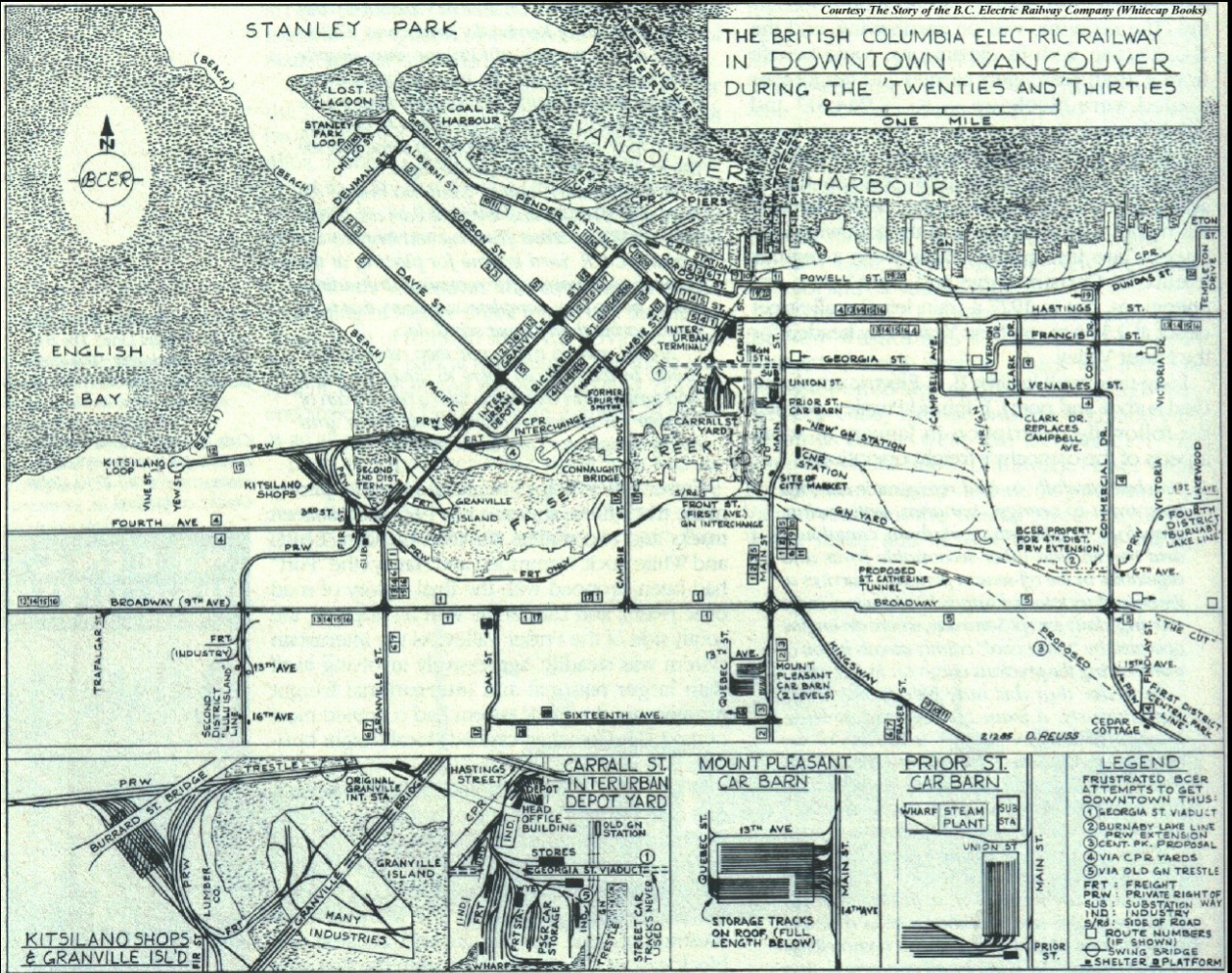
Tom, who seems to have a bottomless well of ephemera when it comes to anything to do with Vancouver history—particularly buildings, theatres and transportation—sent along this map (above) of the BCER in downtown Vancouver from the 1920s.
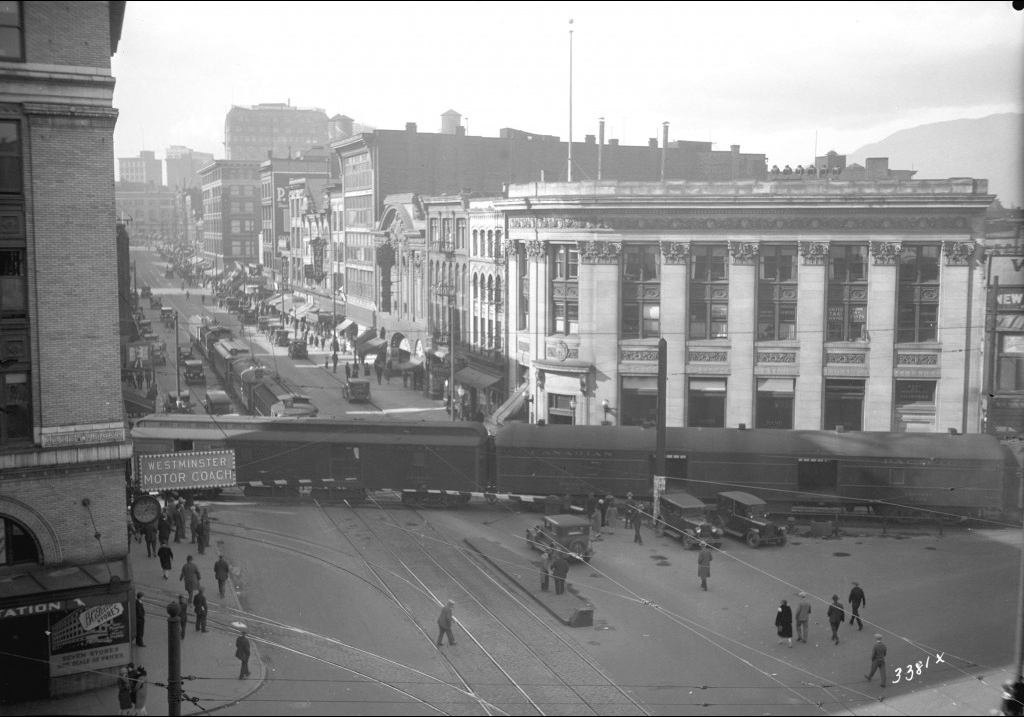
At its height, BC Electric operated 457 streetcars and 84 interurbans.
And, some good news. The BCER’s formal terminal is still there on the corner of Carrall and West Hastings Street.
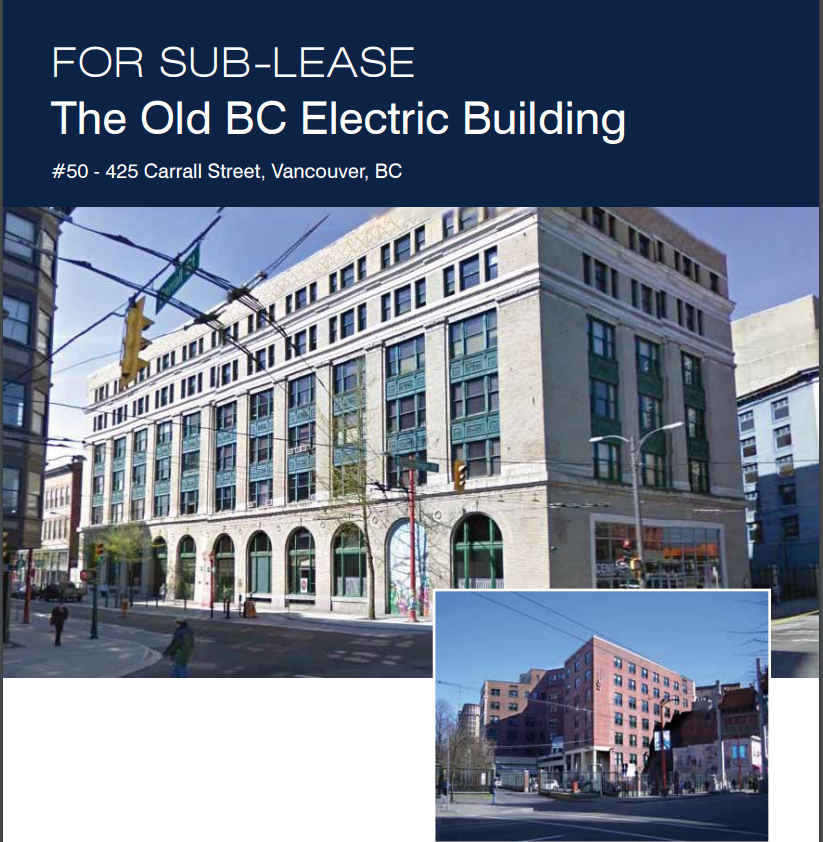
For an upcoming blog I’m going to try and put together a list of the top 10 worst decisions when it comes to destroying Vancouver’s history and heritage. But I’ve got to think that the “from rails to rubber” should be right up there with the demolition of Birks and the second Hotel Vancouver.
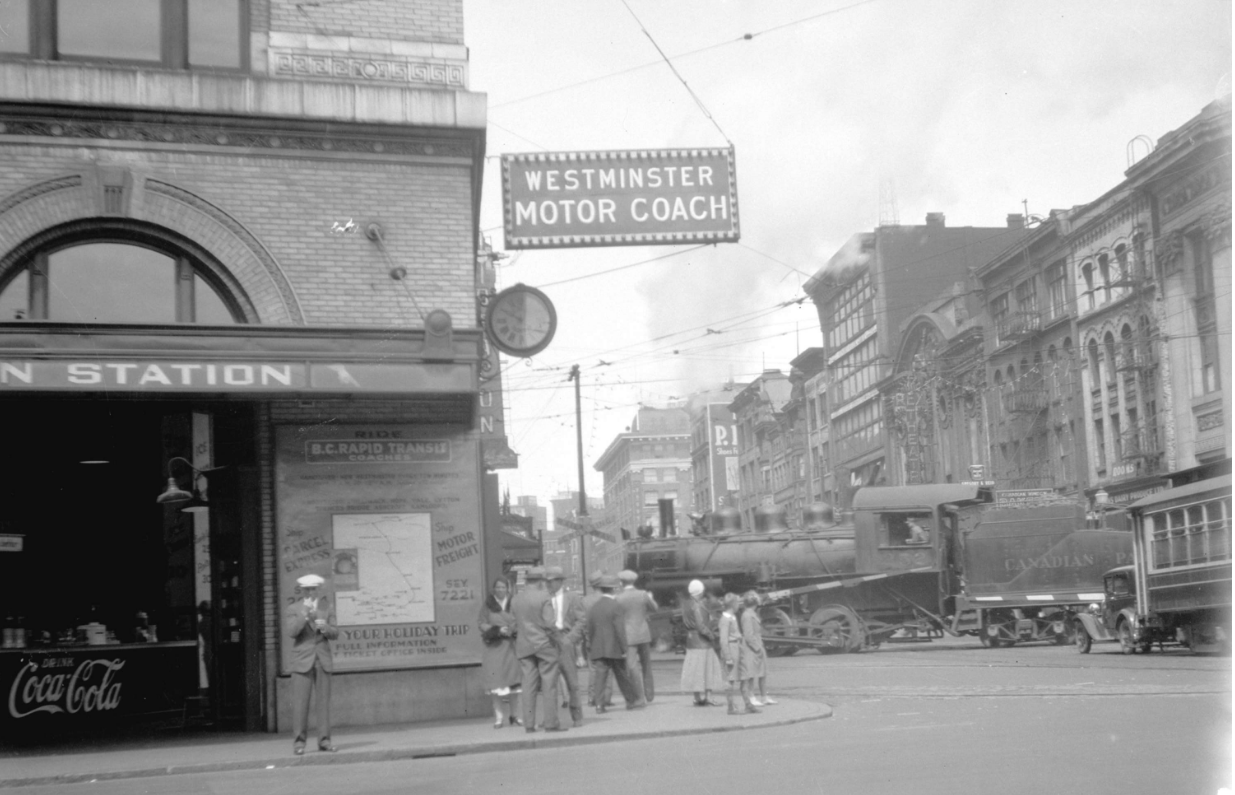
Essentially, rails to rubber meant the end of the streetcars and interurban system. It was a nod to the power of the car and a desire not to spend the money to upgrade the transit system. If you’ve tried to drive across Vancouver lately, you’ll likely agree that it was the dumbest decision ever.
Nevertheless, the last streetcar made its final run in Vancouver in 1955, and three years later, the last of the interurbans finished up service in Steveston.
Sources for this story:
- Tom Carter
- Canadian Rail, Jan-Feb, 2010
- Canada’s Historic Places: BCER Terminal
- The Buzzer Blog: A short history of interurbans in the Lower Mainland, 2009
- For more posts see: Our Missing Heritage
© All rights reserved. Unless otherwise indicated, all blog content copyright Eve Lazarus.




29 comments on “The train that ran down Hastings Street”
My mother used to ride the interurban. Awesome as usual Eve.
Thanks Barbara!
My dad had stories as a kid hitching (read stealing) a ride into Vancouver from New West on the Interurban. Myself as a kid hearing these stories, I thought it was fun and a lark. But seeing these photos for the first time, I now realize what a dangerous thing that was!
It took me a while to realize that the interurbans were actually trains, not streetcars, so yes trying to hitch a ride I imagine would be pretty dangerous!
My late mother took the Interurban from 49 th and West Blvd, in Kerrisdale to her first summer job as a bank teller, downtown in 1946….
Wish we still could Rob!
The last picture is of the Los Angeles “Big Red Cars” not BCER interurbans
Actually, I thought they were trams, found it on the internet and it seemed like a nice punctuation point!
Eve,you are right”,Trams” was another name for the interurbans.I lived 3 houses down on 1 st ave, only a few hundred feet from the Burnaby Lake tram-stop,this made it a blessing when time for shopping rolled around and the whole family headed for town & WOODWARDS .my dad was a conductor, motorman & bus-driver for approx. {in his opinion a ZILLION years} & I think when he retired was “seniority”wise in the bottom 5in BCER. another escapade in my young life not forgetting having a father who worked for the BCER were my fishing trips to the vedder river.There was milk run from Van to Chilliwak ,made up of 2-trams and 1- Big RED -freight tram.my dad knew all the crews and would call one of them to ask for a lift up to the vedder, of course there never was an objection,& guess who tagged along,”THE KID WITH THE RUNNY NOSE” me
So to be the contrarian, the investment to repair and upgrade the streetcar and interurban network after the austerity of the war years was vast, and compounded by the fact that streetcars ran down the centre of the road, not at the curb like buses. Getting off and on became reasonably dangerous with the rise of the automobile. The rails to rubber of the 50s actually left us with the streetcar network intact, just with trolley buses. A far better situation than most cities. Sadly, the interurban system was dismantled and that is something we’re still stuggling with today.
Thanks for stopping by John, we’ll have to arm wrestle over this next time I see you. I grew up in Melbourne surrounded by trams (streetcars) and trains. Rode the tram, to school, to shop, to see movies, etc. Loved it. Yes, they go down the middle of the road, but I don’t ever remember any near death experiences. Still love going back there, getting around is incredibly easy in Melbourne (except for their horrendous Myki payment system). When I was home in February I made my friend take the tram into town just for the experience.
I would very much recommend the Canadian Electric Railway Atlas: http://cermc.webs.com/
It’s a marvelously compiled google-earth map of most electric railway systems in Canada, though it’s a bit cluttered.
Per The Story of the BC Electric Railway, the BCER actually came out of the war intending to retain significant segments of the streetcar and interurban network, but the kicker was when the City announced that they would would replace the Granville Bridge with the existing bridge. There wasn’t enough value in the streetcar system to BCER to justify the capital contribution for rail on the new bridge, and it really cut-off much of the network from downtown. Thus it was decided to rubberize
Thanks so much for all the great additional information Brendan
Great post Eve and excellent chat on the comment thread too! Love the photos you’ve included.
Thanks Will! Let me know when you’re free for a coffee (or beer)
The interurbans actually went all the way out to Chilliwack, and it still boggles my mind that over 100 years ago we had a transit system that offered so much and yet today we don’t.
There is a DVD (I own it) of the interurban doing its entire run….its run to try and spot where it is as so much has changed. I believe I also have a separate DVD of the street cars in Vancouver too….and that one may even be available on YouTube.
Have you seen the Vancouver Historical Society’s DVD City Reflections? They’ve taken the film from 1907 shot on the street car and reshot the same route in 2007. It’s really fascinating to see the changes, and it sounds like the Interurban to Chilliwack would be just as interesting.
Yes, I own that DVD! It’s great!
If I could post a photo here I would…I live in one of two remaining BC Electric Railway Substations, mine being in Sumas Prairie. Ask Tom about it, he’s been here. The Interurban has a great history in the lower mainland, wonderful to read this Eve!
Thanks Christina. Would love to see your place!
I wish Vancouver still had a streetcar system. Whenever I visit Toronto, I always ride their public transit. My friends there think I’m nuts because I love riding the streetcar and the subway, and taking the UP — the Union Pearson Express — to and from the airport. It’s so efficient!
I feel the same way when I go to Melbourne. I take the tram or train for the fun of it
That is not a commuter train running through what we now know as Pioneer Place (a.k.a. Pigeon) Square). That was the regular route that all freight and passenger trains had once used to get back and forth between the Waterfront rail yards on Burrard Inlet and the False Creek rail yard in the years before the Dunsmuir Tunnel was opened in 1932. Once the tunnel’s construction was completed, the railway crossing at Hastings and Carrall Streets became obsolete. That same Dunsmuir Tunnel is now used by Skytrain between the Waterfront and Stadium Stations.
To preface everything, I am an ardent railfan and lover of public transit. The BCER Interurbans hold a special place in my heart.
However, to say that the closure of passenger service on the BCER is one of the top 10 worst decisions in Vancouver’s history is to ignore the historical context of the times. The interurban network was built during a time, and for a city/region, where personal automobile ownership was rare. The interurbans (and the other, limited, suburban railway service) were the only ways for most people to travel between municipalities. However, with the end of the war, we have an economic boom and personal vehicle ownership goes through the roof. Now many Vancouverites (and Burnabyiets, New Westminterians, etc) have choices … take the train, which by this time was in disrepair owing to material and labour shortage through the war, or take your new shiny automobile on any number of the new roads and highways being built. There was simply no contest. The gridlock that paralyzes our city today was still decades away and ridership on the Interurbans dropped off. Remember, these trains were run by the BC Electric Company, at the time, a private, for-profit enterprise. With few passengers riding the rails, the company ended their money-losing passenger service (BC Electric wouldn’t be nationalized into the crown corporation BC Hydro until 1961).
It is easy to look at it in hindsight and say how dumb it was to cancel these trains. After all, all of the rail transit projects built in Vancouver between 1984-2010 have been rough replications of old Interurban routes (in fact, the Expo line of the SkyTrain runs directly on top of the old BCER Central Park Line route from the present New Westminster Station to Commercial-Broadway Station). Only the Evergreen Extension, due to open next month, is the first transit project that doesn’t follow this pattern.
I would also argue that Vancouver’s Streetcar network still exists to this day. It just was transformed into the electric trolley bus network. If you look at the transit map, all of the old streetcar routes are still served by electric trolley buses, many following the same route through the city as the old streetcars … some of them even have the same route number as they did prior to the rails to rubber initiative.
I find it hard to indict the politicians of the day for embracing “Rails to Rubber.” It was a fad across all of North America. In Canada, only one Canadian city maintained their streetcars (Toronto), and in the US, streetcars survived in only 7 cities. It was the sexy, modern thing to be doing. Like the interurbans, the street car system was in a state of disrepair following the war. So either way, a large infusion of cash into the transit system was needed. If you place yourself in the shoes of the politicians of the day, it is hard to fault them for investing in–what was at the time considered–the most modern and efficient transit option. In fact, rails to rubber did increase the transit capacity of the network. In the downtown core of Vancouver, streetcar lines were double-tracked, however once you got away from the downtown (remember, in the early 50s, anything south of 12 ave was getting into the burbs), most streetcar lines were single tracked, severely limiting the frequency of trains.
Lovely picture choices and the story of the BCER is one that needs telling. Thankfully, the BCER Terminal at Hastings and Carrol is not the only remnant of the old system around. With a keen eye, there several signs around the region of the railway that was. Of course, you can also ride on restored BCER interurban cars in Cloverdale on the weekends through the summer, courtesy of a fantastic group of volunteers.
This is fascinating Ted. Thanks so much for taking the time to add another side to the story.
The building you show, The B. C. Electric Building was the power plant for the tram cars. They ran on 600 Volts DC.
The steam train you see entering the building was bringing their supply of coal.
If you go in the lobby of the building you will see the steam train causing a traffic jam as it closed Pender St. 3 cars, and 1 tram.
Because of this the train was put into a tunnel that they ran under ground through Gastown.
The tunnel was eventually used as a speak easy during prohibition.
Visit Nelson BC where you can actually ride in streetcar # 23, a 1912 unit that Nelson bought from a used streetcar dealer about 1918. Beautifully restored and maintained and run by volunteers from May to late October.
[…] early as 1914, there were calls for an end to the Carrall and Hastings Street crossing, where freight and passenger trains could hold up traffic for up to an hour a day getting from the […]
[…] https://evelazarus.com/the-train-that-ran-down-hastings-street/ […]